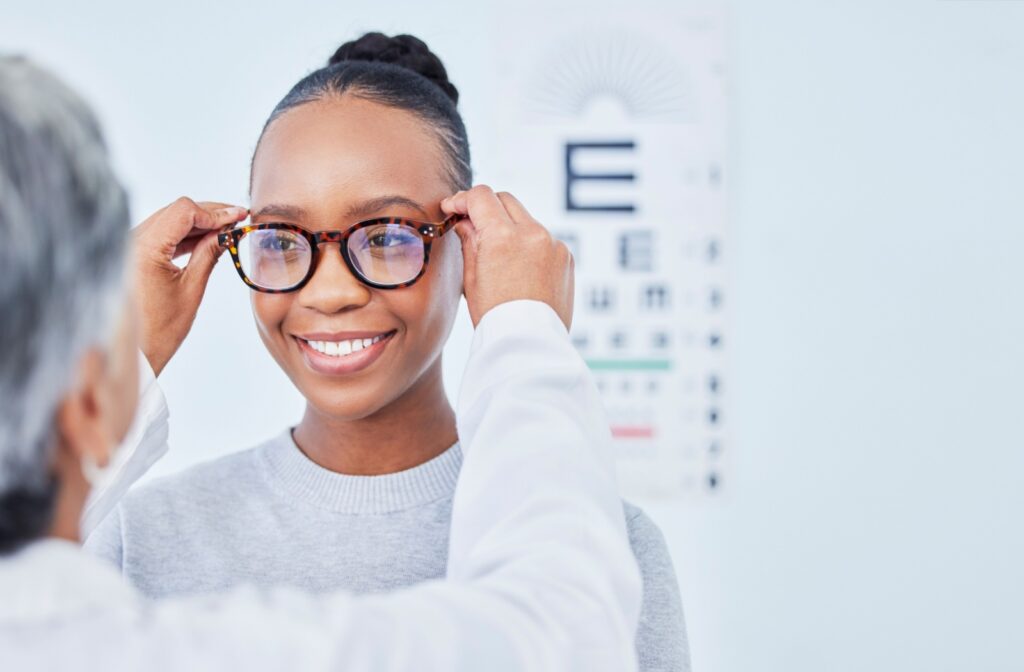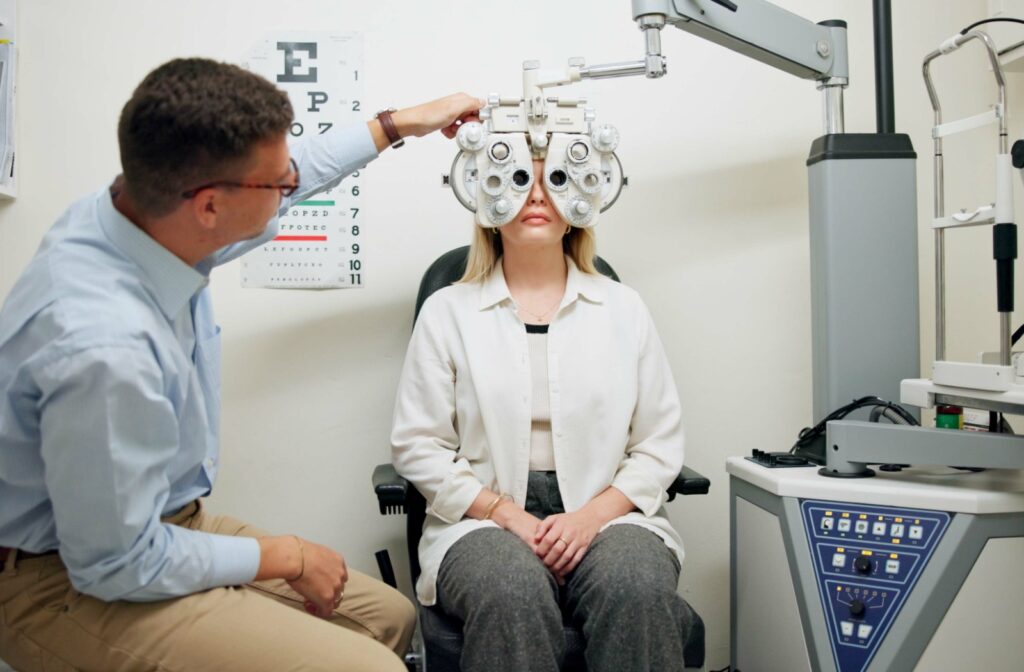An eye exam is a comprehensive assessment of both your vision and eye health. During an eye exam, your optometrist will evaluate:
- How well you see
- How your eyes work together
- The health of internal and external eye structures
These steps help identify vision changes, detect eye diseases early, and ensure your eyes are functioning at their best. Understanding what happens during an eye exam can help you feel prepared and confident, whether it’s your first visit or a routine checkup.
Comprehensive Eye Exams
A comprehensive eye exam goes beyond simply checking whether you need glasses. It evaluates the full health of your eyes, revealing potential issues before they escalate. An eye exam can even detect early signs of systemic health conditions such as diabetes or high blood pressure.
Let’s have a look at what a comprehensive eye exam involves.
Reviewing Your Medical & Vision History
To start, your optometrist or technician will gather details about your general health and vision history. This conversation may cover topics such as:
- Any vision problems you’ve experienced (e.g., blurry vision, eye strain).
- Your medical history, including illnesses or medications that can affect vision.
- Family history of eye conditions like glaucoma or macular degeneration.
Testing Visual Acuity
Your optometrist will measure how clearly you can see. To do this, they’ll have you read increasingly small rows of letters off of a Snellen chart. The smaller the letters you’re able to read, the stronger your vision.
This test evaluates whether you have issues with near or distance vision that may require corrective lenses.
Eye Muscle Movement & Coordination
The next step involves assessing how well your eye muscles work together. Your optometrist will have you follow a small light or object with your eyes to examine movement and coordination. This confirms that your eyes are working in sync.
Problems with eye muscle function can lead to symptoms like double vision or strain, especially during activities such as reading or using a computer.
Measuring Eye Pressure for Glaucoma
Glaucoma is a condition that can damage the optic nerve and lead to vision loss if untreated. To screen for this condition, a technician will measure the pressure inside your eyes using a process called tonometry.
Don’t worry—it’s a quick and simple test. Sometimes a gentle puff of air is used, or a small device may briefly touch the surface of your eye (in such cases, numbing drops are applied beforehand, so it’s not uncomfortable).
Catching elevated eye pressure early is key to managing and preventing serious complications from glaucoma.
Assessing the Health of Your Eyes
Eye health involves much more than just how well you can see. Through a series of tests and observations, your optometrist will evaluate the overall health of your eyes. Some of the factors they’ll look at include:
- Pupil Response: Checking how your pupils react to light.
- Cornea and Lens Inspection: Using tools like a slit lamp, your optometrist can closely examine the front parts of your eye.
- Retinal Examination: By dilating your pupils, they can get a detailed look at your retina, optic nerve, and blood vessels at the back of your eye. This step can detect issues like retinal tears, macular degeneration, or even signs of diabetes.
Checking Your Prescription Needs
If you need corrective lenses, your optometrist will refine your prescription through a process called refraction.
You’ll view a series of lens options through a device called a phoropter and share which lens provides the clearest image. This ensures that your prescription is tailored to your vision needs.

Specialized Tests for Specific Concerns
For certain people, additional specialized tests may be recommended. These tests might include:
- Visual Field Testing: Measures your peripheral (side) vision to check for any gaps that could indicate glaucoma or other issues.
- Color Vision Testing: Ensures your ability to distinguish colors accurately.
- Imaging Tests: Advanced imaging like Optical Coherence Tomography (OCT) can provide detailed scans of your retina for conditions like macular degeneration or diabetic retinopathy.
These specialized tests target specific concerns and provide even deeper insights into your eye health.
How to Prepare for an Eye Exam
A little preparation can make your eye exam even smoother:
- Bring a list of any medications you’re taking.
- Note any vision problems or symptoms you’ve noticed recently.
- If you wear glasses or contact lenses, bring them along.
- Be ready to discuss your work and hobbies, as they can influence your vision needs (e.g. if you spend long hours at a screen).
Being proactive about sharing information ensures the optometrist can give you the most accurate recommendations.
Why Routine Eye Exams Are Important
Regular eye exams are important for everyone, regardless of age or vision status. Even if you don’t need corrective lenses, regular vision check-ups can spot potential issues early, leading to better treatment outcomes.
For certain conditions, like glaucoma, early detection can be the difference between maintaining and losing vision.
Eye exams also provide an opportunity to recalibrate your prescription, ensuring your glasses or contact lenses are still meeting your needs. That’s why they’re a powerful tool for safeguarding your long-term eye health.
Ready for an Eye Exam?
An eye exam is a simple checkup that plays an important role in maintaining both your vision and eye health.
From updating your prescription to checking for eye diseases or spotting other health issues, regular exams provide valuable insights. If you’re ready for your next eye exam, book your appointment with Riverside Optometry.



